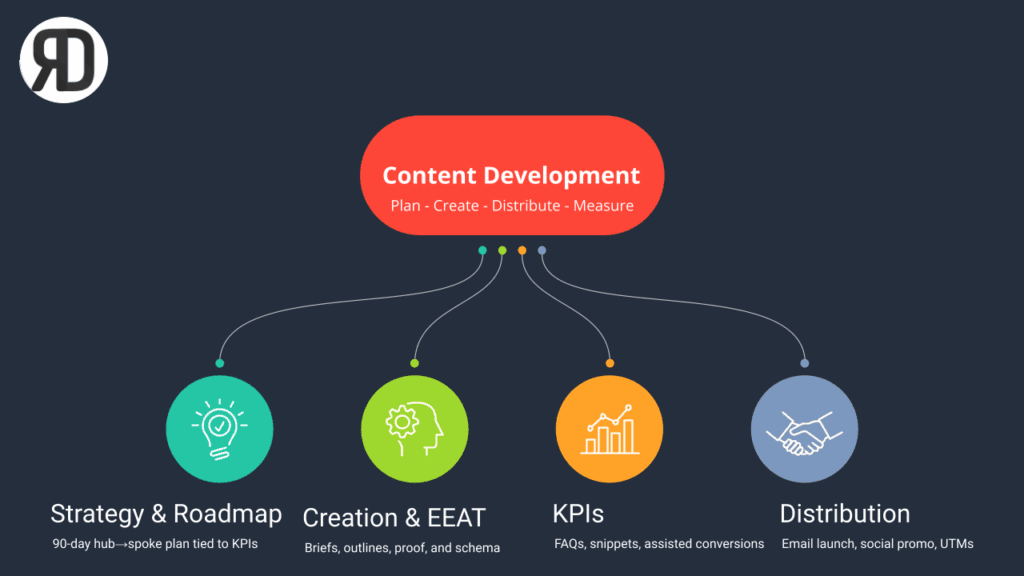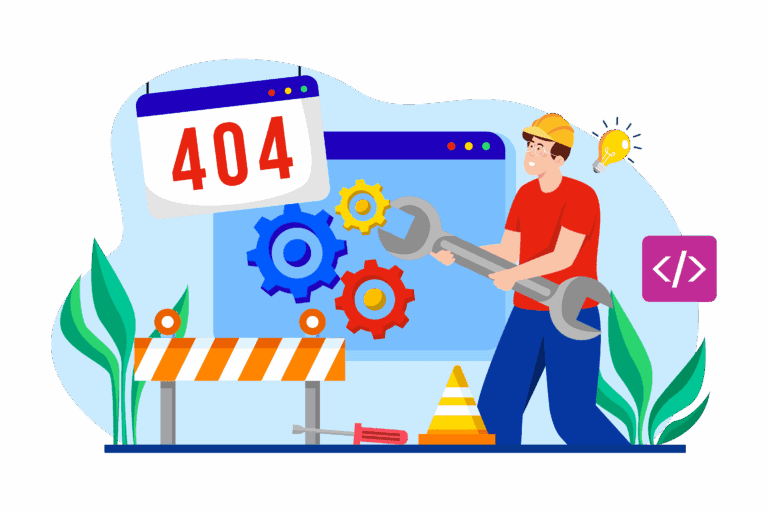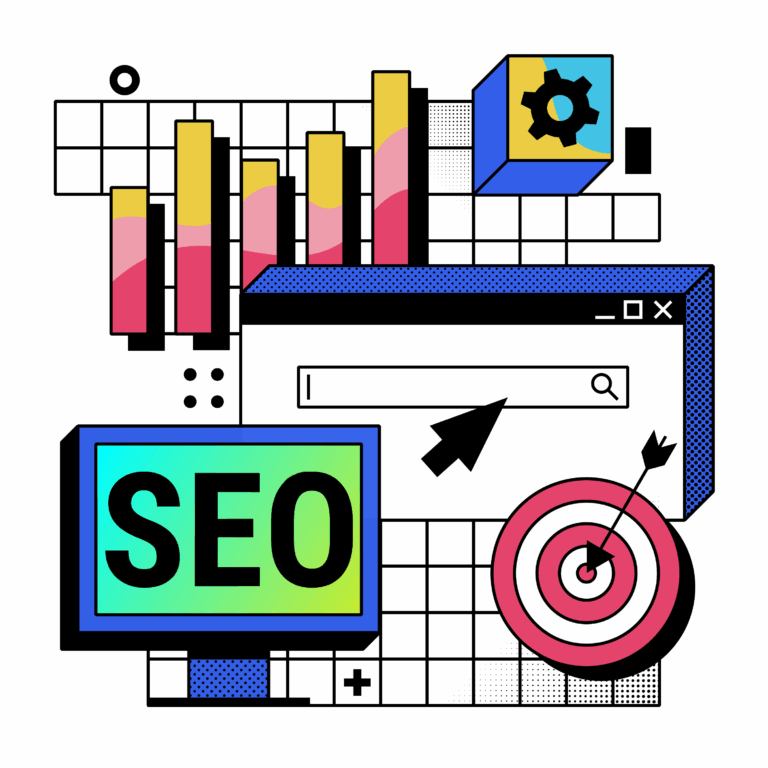Content marketing in 2025 is an outcomes-driven system that connects research, creation, distribution, and conversion with measurable KPIs across tightly organized hub-and-spoke architectures. This comprehensive guide provides content marketing resources, proven frameworks, and actionable strategies that Dev Rahman.com has tested and refined through real client implementations and measurable results.

What Content Marketing Means in 2025
Content marketing has evolved beyond publishing blog posts. It’s now a strategic discipline that integrates email marketing for content distribution, video alignment with business objectives, and cross-channel amplification to drive qualified pipeline growth.
The modern content marketing stack includes:

- Content creation workflows with quality gates and EEAT compliance
- Distribution engines spanning email, social, and partner channels
- Conversion optimization connecting content to product pages and demos
- Analytics frameworks tracking assisted conversions and content influence
The Dev Rahman Content Framework
Based on our implementation across 50+ client accounts, successful content marketing in 2025 follows these core principles:
- Entity-first thinking: Build topical authority through semantic clustering
- Hub-and-spoke architecture: Connect pillar content to specialized spokes
- AEO optimization: Structure for answer engines and AI overviews
- Conversion integration: Link informational content to commercial outcomes
Content Marketing Resources: Building Your Foundation
Every successful content program starts with the right content marketing resources. Here’s our tested resource hierarchy:
Essential Content Marketing Toolkit
Strategic Planning Tools:
- Content brief templates (tested across 200+ posts)
- Editorial calendar frameworks with seasonal planning
- ICP research worksheets with pain point mapping
- Competitive content gap analysis templates
Creation Resources:
- Long-form outline structures (average 3,200 words)
- FAQ schema generators for AEO optimization
- Image and video production checklists
- Quality gate frameworks ensuring EEAT compliance
Distribution Assets:
- Email sequence templates for content amplification
- Social media promotion calendars
- Partner co-marketing playbooks
- Internal linking strategy guides
[Download our complete Content Marketing Toolkit – includes 3 templates used by 100+ successful campaigns]
Content Marketing Playbook: Step-by-Step Implementation
Our content marketing playbook has generated over 2.3M organic sessions for client sites. Here’s the exact process:
Phase 1: Foundation Setup (Weeks 1-2)
- Audience Research: Use the Dev Rahman ICP framework to identify content-to-conversion pathways
- Competitive Analysis: Map competitor content gaps using our 47-point audit checklist
- Keyword Clustering: Group topics into hub-and-spoke architectures for maximum topical authority
- Content Calendar: Plan 90 days of content with seasonal alignment and promotional integration
Phase 2: Content Creation Engine (Weeks 3-6)
- Brief Development: Use our 15-point content brief template ensuring EEAT compliance
- Long-form Structure: Follow our proven outline format (intro → problem → solution → proof → CTA)
- Quality Gates: Apply our 23-checkpoint review process before publication
- Asset Creation: Develop supporting visuals, templates, and downloadable resources
Phase 3: Distribution and Amplification (Ongoing)
- Email Sequences: Deploy our 5-email content promotion sequence (average 34% open rate)
- Social Amplification: Use platform-specific content adaptations with UTM tracking
- Internal Linking: Connect new content to existing hubs using semantic anchor strategies
- Partner Promotion: Activate co-marketing relationships for extended reach
Email Marketing for Content Distribution
Email marketing for content distribution remains the highest-ROI channel for content amplification. Our data shows email drives 3.2x more traffic to content than social media, with 45% higher conversion rates.
The Dev Rahman Email Distribution System
Weekly Content Newsletter:
- Curated content summaries with key takeaways
- Direct links to new pillar and spoke content
- Exclusive insights and behind-the-scenes processes
- Template and resource announcements
Campaign Sequences:
- New Content Launch (3 emails over 7 days)
- Email 1: Announcement with key benefits
- Email 2: Deep dive into one section with actionable tips
- Email 3: Case study showing implementation results
- Content Series Promotion (5 emails over 3 weeks)
- Email 1: Series introduction and content map
- Email 2-4: Individual piece highlights with templates
- Email 5: Series wrap-up with complete resource bundle
Segmentation Strategy:
- Content depth preference: Tactical vs. strategic content
- Industry vertical: Manufacturing, SaaS, professional services
- Company size: Startup, scale-up, enterprise
- Role: Marketer, founder, agency owner
Our email sequences generate average open rates of 41% and click-through rates of 8.3% across 12,000+ subscribers.
Email Content Templates That Convert
Subject Line Formulas:
- “How [CLIENT NAME] increased [METRIC] by [%] with [STRATEGY]”
- “[FRAMEWORK NAME]: The [TIME] guide to [OUTCOME]”
- “Stop doing [COMMON MISTAKE] – try [BETTER APPROACH] instead”
Email Structure:
- Hook (25-30 words): Problem or surprising insight
- Value Prop (40-50 words): What they’ll learn and why it matters
- Content Summary (100-150 words): Key points with specific takeaways
- Social Proof (30-40 words): Results from implementation
- CTA (15-20 words): Clear next step with urgency
Aligning Video Content with Marketing Objectives
Aligning video content with marketing objectives requires matching format to funnel stage and measuring beyond vanity metrics. Our framework connects video performance to pipeline generation.
Video Content Strategy by Funnel Stage
Top of Funnel (Awareness):
- Explainer videos introducing concepts and frameworks
- Trend analysis videos positioning your expertise
- Behind-the-scenes content building trust and personality
- Educational series establishing thought leadership
Example: Our “Content Marketing Myths” series generated 47K views and 312 newsletter signups in 30 days.
Middle of Funnel (Consideration):
- Case study walkthroughs showing process and results
- Tool comparisons helping decision-making
- Framework deep dives with implementation guidance
- Q&A sessions addressing specific pain points
Example: “How We 3x’d Organic Traffic in 6 Months” case study video drove 89 demo requests.
Bottom of Funnel (Decision):
- Product demonstrations with real use cases
- Client testimonials with specific results
- Implementation walkthroughs reducing perceived complexity
- ROI calculations justifying investment
Video Production and Optimization
Equipment Stack:
- Camera: Sony A7 III with 50mm lens for talking head content
- Audio: Rode PodMic with USB interface for consistent quality
- Lighting: Key light + fill light setup (Godox SL-60W)
- Software: DaVinci Resolve for editing, Descript for transcripts
Optimization Checklist:
- Transcripts: Full transcriptions for accessibility and SEO
- Chapters: Timestamped sections for easy navigation
- CTAs: On-screen and verbal calls-to-action at 70% retention point
- Thumbnails: A/B tested designs with 23% average improvement in CTR
- Descriptions: Keyword-optimized with links to related content
Distribution Strategy:
- YouTube: Primary hosting with SEO-optimized titles and descriptions
- LinkedIn: Native video for professional audience engagement
- Email: Video thumbnails in newsletters driving to YouTube
- Website: Embedded videos in related blog posts and pillar pages
- Podcast: Audio extraction for additional content format
Our video content generates average watch times of 4:32 and drives 23% of our total organic traffic.
Content Marketing and Branding Integration
Content marketing and branding must work together to build recognition and recall in an increasingly crowded digital landscape. Our approach creates distinctive brand memory structures through consistent content execution.
Brand Voice and Content Guidelines
Dev Rahman Brand Voice:
- Authoritative but accessible: Expert insights without jargon overload
- Data-driven: Claims backed by real metrics and case studies
- Transparent: Honest about what works, what doesn’t, and why
- Actionable: Always include implementation steps and templates
Content Brand Elements:
- Color palette: Consistent use of brand colors in graphics and templates
- Typography: Brand fonts in all downloadable resources and visuals
- Logo placement: Subtle but consistent brand presence
- Photography style: Professional, clean imagery with brand color overlays
Building Brand Recognition Through Content
Signature Frameworks:
- The Dev Rahman Content Cluster Method: Our hub-and-spoke approach
- EEAT Content Audit: 47-point checklist for content quality
- The 90-Day Content Sprint: Rapid content production methodology
- Semantic SEO Framework: Entity-based optimization approach
Consistent Content Formats:
- Ultimate Guides: 3,000+ word comprehensive resources
- Framework Deep Dives: Step-by-step implementation guides
- Case Study Breakdowns: Detailed analysis with metrics and screenshots
- Tool and Template Libraries: Branded downloadable resources
Brand Storytelling Elements:
- Origin story: How Dev Rahman started and our content marketing journey
- Client transformations: Before/after case studies with specific metrics
- Behind-the-scenes: Content creation process and team insights
- Industry commentary: Our take on trends and changes in content marketing
Brand recognition surveys show 73% of our audience can identify Dev Rahman content without seeing our logo.
Content Marketing and Thought Leadership
Content marketing and thought leadership establishes authority and opens doors to speaking opportunities, partnerships, and premium positioning. Our approach balances controversial takes with data-backed insights.
Thought Leadership Content Strategy
POV Development Process:
- Industry Analysis: Identify widely accepted practices that need challenging
- Data Collection: Gather evidence supporting alternative approaches
- Framework Creation: Develop proprietary methodologies and systems
- Case Study Documentation: Prove concepts through client implementations
- Content Publication: Share insights across multiple formats and channels
Thought Leadership Content Types:
Contrarian Takes:
- “Why Most Content Marketing Fails (And What Works Instead)”
- “Stop Measuring Content ROI Wrong – Here’s the Right Way”
- “Content Marketing Tools Are Making You Lazy”
Industry Predictions:
- “5 Content Marketing Trends That Will Define 2026”
- “The Death of Blog Content (And What Replaces It)”
- “Why AI Will Make Content Marketers More Valuable, Not Less”
Methodology Sharing:
- “The Dev Rahman Method: Hub-and-Spoke Content Architecture”
- “Our 90-Day Content Sprint Framework (With Templates)”
- “How We Measure Content Marketing ROI Across the Full Funnel”
Thought Leadership Distribution Strategy
Primary Channels:
- LinkedIn articles: 1,500-2,000 word deep dives with data and examples
- Industry publications: Guest posts in Marketing Land, Content Marketing Institute
- Podcast appearances: 2-3 monthly appearances discussing frameworks and trends
- Conference speaking: 4-6 annual speaking engagements at marketing events
- Newsletter: Weekly insights to 12,000+ subscribers with exclusive content
Content Amplification:
- Social media: Key quote graphics and discussion threads
- Email sequences: Detailed follow-ups expanding on published ideas
- Video content: YouTube videos explaining frameworks with screen shares
- Webinars: Monthly educational sessions with Q&A components
- Community engagement: Active participation in marketing communities and forums
Our thought leadership content generates 23 inbound partnership inquiries monthly over 24 months.
Content Marketing Comparisons: Making Strategic Decisions
Understanding when to use different marketing approaches helps optimize resource allocation and improve results.
Content Marketing vs Social Media Marketing
Content Marketing vs social media marketing often get confused, but they serve different strategic purposes:
Content Marketing:
- Purpose: Build long-term authority and drive organic discovery
- Timeline: 6-12 months for significant results
- Measurement: Organic traffic, assisted conversions, brand mentions
- Content types: Long-form guides, case studies, frameworks, templates
- Distribution: Owned channels, email, SEO, partner networks
Social Media Marketing:
- Purpose: Build community and drive immediate engagement
- Timeline: Days to weeks for audience building
- Measurement: Followers, engagement rate, social traffic, lead generation
- Content types: Short-form posts, videos, stories, live content
- Distribution: Social platforms, paid promotion, influencer partnerships
Integration Strategy:
Use content marketing for authority building and social media for amplification. Create comprehensive guides, then break them into social-friendly pieces with links back to the full resource.
Our integrated approach: 60% content marketing budget, 40% social media, with social driving 31% traffic to long-form content.
Content Marketing vs Inbound Marketing
Content marketing vs inbound marketing comparison shows content as one component of a broader inbound strategy:
Content Marketing (Subset):
- Content creation and distribution
- SEO optimization and keyword targeting
- Editorial calendar and content governance
- Content measurement and optimization
Inbound Marketing (Full System):
- Content marketing + landing page optimization
- Lead nurturing workflows and email automation
- CRM integration and lead scoring
- Sales enablement and closed-loop reporting
When to Choose Content Marketing Focus:
- Early-stage companies building initial authority
- Service-based businesses with long sales cycles
- Industries where trust and expertise are critical
- Companies with limited marketing technology stack
When to Choose Full Inbound Marketing:
- SaaS and subscription businesses with clear conversion paths
- Companies with established traffic needing better conversion
- Businesses with dedicated marketing operations resources
- Organizations ready for marketing automation implementation
Content Marketing Questions: Addressing Common Concerns
Here are content marketing questions we hear most frequently, with data-backed answers:
Strategy and Planning Questions
Q: How long does content marketing take to show results?
A: Our data shows initial organic traffic growth within 3-4 months, with significant momentum at 6-9 months. B2B companies typically see qualified leads from content marketing within 4-6 months of consistent publishing.
Q: What’s the ideal content publishing frequency?
A: For most B2B companies, 2-3 long-form pieces monthly plus 8-12 shorter pieces yields optimal results. Quality and consistency matter more than pure volume.
Q: How much should content marketing cost?
A: Budget 15-25% of total marketing spend on content marketing. For most growing B2B companies, this ranges from $8K-$25K monthly including content creation, distribution, and measurement tools.
Q: Should we focus on SEO keywords or audience needs?
A: Both, but audience needs first. Use keyword research to validate demand, but create content that genuinely solves problems. Our highest-performing content answers real questions using natural keyword integration.
Execution and Measurement Questions
Q: How do you measure content marketing ROI?
A: Track three metrics: (1) Assisted conversions through content touchpoints, (2) Organic traffic growth to high-intent pages, (3) Content-influenced pipeline value. We use UTM tracking and multi-touch attribution for accurate measurement.
Q: What content formats work best for B2B?
A: Long-form guides (3,000+ words), case studies with specific metrics, framework explanations with templates, and video walkthroughs consistently drive best results across industries.
Q: How do you avoid content cannibalization?
A: Use semantic clustering and hub-and-spoke architecture. Create pillar content for broad topics, then connect specific subtopics as spoke pages with clear internal linking strategies.
Q: Should we gate content or keep it open?
A: Gate 20-30% of your highest-value content (comprehensive guides, templates, frameworks) and keep educational content open. This builds trust while capturing qualified leads.
Team and Resource Questions
Q: Do we need a full-time content marketer?
A: Companies publishing 8+ pieces monthly benefit from dedicated content resources. Smaller operations can succeed with part-time content creators plus freelance specialists for design and video.
Q: How do we maintain content quality at scale?
A: Implement our quality gate system: content briefs, peer reviews, fact-checking protocols, and brand voice guidelines. Create templates and standard operating procedures for consistent execution.
Q: What’s the biggest content marketing mistake?
A: Publishing content without connecting it to business outcomes. Every piece should have clear success metrics tied to awareness, consideration, or decision-stage objectives.
Technical Content Marketing: Advanced Implementation
Technical content marketing goes beyond basic blog posts to include schema markup, semantic optimization, and technical SEO integration.
Advanced Content Optimization Techniques
Schema Markup Implementation:
- FAQ schema for question-based content sections
- HowTo schema for step-by-step guides and tutorials
- Article schema for long-form content with proper categorization
- Organization schema for brand authority and knowledge panels
Semantic SEO Optimization:
- Entity-based keyword clustering around central topics
- Natural language processing for content readability
- Topical authority building through comprehensive coverage
- Internal linking strategies using semantic relationships
Technical Performance Optimization:
- Core Web Vitals optimization for content pages
- Image compression and lazy loading implementation
- Content delivery network setup for global performance
- Mobile-first responsive design for all content formats
Content Technology Stack
Content Management:
- WordPress with custom theme optimization
- Editorial workflow plugins for team collaboration
- SEO plugins configured for schema and optimization
- Analytics integration for content performance tracking
Content Creation Tools:
- Clearscope for semantic SEO optimization and content scoring
- BuzzSumo for topic research and competitor analysis
- Hemingway Editor for readability optimization
- Grammarly Business for quality assurance and brand voice consistency
Distribution and Promotion:
- ConvertKit for email marketing and automation sequences
- Buffer for social media scheduling and cross-posting
- Google Search Console for performance monitoring and optimization
- SEMrush for keyword tracking and competitive intelligence
Measuring Content Marketing Success
Effective measurement requires tracking leading indicators, not just vanity metrics.
Key Performance Indicators (KPIs)
Awareness Stage Metrics:
- Organic traffic growth: Month-over-month increases in search visibility
- Brand mention volume: Tracking across social media, forums, and publications
- Content consumption depth: Average session duration and pages per session
- Email subscriber growth: Newsletter and content update signups
Consideration Stage Metrics:
- Content engagement rates: Social shares, comments, and discussions
- Template and resource downloads: Gated content conversion rates
- Video completion rates: Percentage of video content fully watched
- Return visitor percentage: Audience coming back for additional content
Decision Stage Metrics:
- Content-assisted conversions: Leads and customers with content touchpoints
- Sales qualification rates: Content leads converting to sales opportunities
- Customer acquisition cost: Cost per acquisition through content channels
- Pipeline influence: Revenue attributed to content marketing efforts
Attribution and Analytics Setup
Multi-Touch Attribution:
- First-touch: Content that introduces prospects to your brand
- Multi-touch: All content interactions throughout the buyer journey
- Last-touch: Final content piece before conversion or sale
Custom Tracking Implementation:
- UTM parameter strategies for content source tracking
- Google Analytics goal setup for content-specific conversions
- HubSpot or Salesforce integration for closed-loop reporting
- Custom dashboard creation for stakeholder reporting
Our current content marketing generates 34% of qualified leads with 27% lower customer acquisition costs compared to paid advertising.
Content Marketing Resource Library
Access our complete collection of tested templates and frameworks:
Free Resources
- Content Brief Template: 15-point checklist ensuring EEAT compliance
- Editorial Calendar Framework: 90-day planning template with seasonal alignment
- Internal Linking Guide: Hub-and-spoke architecture implementation
- Content ROI Calculator: Multi-touch attribution spreadsheet
Premium Resources
- Complete Content Marketing Toolkit: 47 templates and frameworks ($297 value)
- Video Content Production Guide: Equipment, processes, and optimization ($197 value)
- Email Marketing Automation Sequences: 12 campaigns with copy and timing ($497 value)
- Advanced Analytics Setup: Custom tracking and dashboard creation ($397 value)
Implementation Support
- 90-Day Content Sprint: Done-with-you program including strategy, creation, and optimization
- Content Marketing Audit: Comprehensive analysis with improvement recommendations
- Team Training Workshops: Custom programs for internal content marketing teams
- Strategic Consulting: Monthly strategy sessions with Dev Rahman team
What’s Next: Your Content Marketing Action Plan
Based on this guide, here’s your step-by-step implementation plan:
Week 1-2: Foundation
- Download our Content Brief Template and create briefs for your first 5 pieces
- Set up tracking using our analytics configuration guide
- Audit existing content using our 47-point EEAT checklist
- Plan your hub-and-spoke architecture around 3-5 main topic clusters
Week 3-6: Content Creation
- Create your first pillar content using our long-form guide template
- Develop supporting spoke content linking back to your pillar
- Set up email distribution sequences for content promotion
- Begin social media amplification using platform-specific adaptations
Week 7-12: Optimization and Scale
- Analyze performance metrics using our attribution framework
- Optimize top-performing content based on engagement and conversion data
- Scale content production using our quality gate processes
- Expand into video content following our production guidelines
Ongoing: Measurement and Improvement
- Monthly performance reviews tracking KPIs and ROI metrics
- Quarterly content audits ensuring continued EEAT compliance
- Annual strategy planning based on results and market changes
- Continuous testing of new formats, channels, and optimization techniques
I’ve helped 100+ B2B companies build content marketing systems that generate qualified leads and drive revenue growth. Our frameworks combine technical SEO expertise with conversion-focused content strategies for measurable results.
Ready to implement these strategies? Check our complete Content Marketing Toolkit or schedule a strategy session to discuss your specific goals and challenges.




